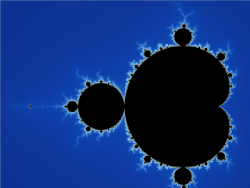
Back مجموعة ماندلبرو Arabic Conxuntu de Mandelbrot AST Мандельброт күплеге Bashkir Множество на Манделброт Bulgarian ম্যান্ডেলব্রট সেট Bengali/Bangla Conjunt de Mandelbrot Catalan کۆمەڵەی ماندێلبرۆت CKB Mandelbrotova množina Czech Mandelbrotmængden Danish Mandelbrot-Menge German
This article needs additional citations for verification. (June 2024) |

The Mandelbrot set (/ˈmændəlbroʊt, -brɒt/)[1][2] is a two-dimensional set that is defined in the complex plane as the complex numbers for which the function does not diverge to infinity when iterated starting at , i.e., for which the sequence , , etc., remains bounded in absolute value.[3]
This set was first defined and drawn by Robert W. Brooks and Peter Matelski in 1978, as part of a study of Kleinian groups.[4] Afterwards, in 1980, Benoit Mandelbrot obtained high-quality visualizations of the set while working at IBM's Thomas J. Watson Research Center in Yorktown Heights, New York.[5]

Images of the Mandelbrot set exhibit an infinitely complicated boundary that reveals progressively ever-finer recursive detail at increasing magnifications;[6][7] mathematically, the boundary of the Mandelbrot set is a fractal curve.[8] The "style" of this recursive detail depends on the region of the set boundary being examined.[9] Mandelbrot set images may be created by sampling the complex numbers and testing, for each sample point , whether the sequence goes to infinity.[10][close paraphrasing] Treating the real and imaginary parts of as image coordinates on the complex plane, pixels may then be colored according to how soon the sequence crosses an arbitrarily chosen threshold (the threshold must be at least 2, as −2 is the complex number with the largest magnitude within the set, but otherwise the threshold is arbitrary).[10][close paraphrasing] If is held constant and the initial value of is varied instead, the corresponding Julia set for the point is obtained.[11]
The Mandelbrot set is well-known,[12] even outside mathematics,[13] for how it exhibits complex fractal structures when visualized and magnified, despite having a relatively simple definition.[14][15][16]
- ^ "Mandelbrot set". Lexico UK English Dictionary. Oxford University Press. Archived from the original on 31 January 2022.
- ^ "Mandelbrot set". Merriam-Webster.com Dictionary. Merriam-Webster. Retrieved 30 January 2022.
- ^ Cooper, S. B.; Löwe, Benedikt; Sorbi, Andrea (28 November 2007). New Computational Paradigms: Changing Conceptions of What is Computable. Springer Science & Business Media. p. 450. ISBN 978-0-387-68546-5.
- ^ Cite error: The named reference
:0was invoked but never defined (see the help page). - ^ Nakos, George (20 May 2024). Elementary Linear Algebra with Applications: MATLAB®, Mathematica® and MaplesoftTM. Walter de Gruyter GmbH & Co KG. p. 322. ISBN 978-3-11-133185-0.
- ^ Addison, Paul S. (1 January 1997). Fractals and Chaos: An illustrated course. CRC Press. p. 110. ISBN 978-0-8493-8443-1.
- ^ Briggs, John (1992). Fractals: The Patterns of Chaos : a New Aesthetic of Art, Science, and Nature. Simon and Schuster. p. 77. ISBN 978-0-671-74217-1.
- ^ Hewson, Stephen Fletcher (2009). A Mathematical Bridge: An Intuitive Journey in Higher Mathematics. World Scientific. p. 155. ISBN 978-981-283-407-2.
- ^ Peitgen, Heinz-Otto; Richter, Peter H. (1 December 2013). The Beauty of Fractals: Images of Complex Dynamical Systems. Springer Science & Business Media. p. 166. ISBN 978-3-642-61717-1.
the Mandelbrot set is very diverse in its different regions
- ^ a b Hunt, John (1 October 2023). Advanced Guide to Python 3 Programming. Springer Nature. p. 117. ISBN 978-3-031-40336-1.
- ^ Campuzano, Juan Carlos Ponce (20 November 2020). "Complex Analysis". Complex Analysis — The Mandelbrot Set. Archived from the original on 16 October 2024. Retrieved 5 March 2025.
- ^ Oberguggenberger, Michael; Ostermann, Alexander (24 October 2018). Analysis for Computer Scientists: Foundations, Methods, and Algorithms. Springer. p. 131. ISBN 978-3-319-91155-7.
- ^ "Mandelbrot Set". cometcloud.sci.utah.edu. Retrieved 22 March 2025.
- ^ Peitgen, Heinz-Otto; Jürgens, Hartmut; Saupe, Dietmar (6 December 2012). Fractals for the Classroom: Part Two: Complex Systems and Mandelbrot Set. Springer Science & Business Media. p. 415. ISBN 978-1-4612-4406-6.
- ^ Gulick, Denny; Ford, Jeff (10 May 2024). Encounters with Chaos and Fractals. CRC Press. pp. §7.2. ISBN 978-1-003-83578-3.
- ^ Bialynicki-Birula, Iwo; Bialynicka-Birula, Iwona (21 October 2004). Modeling Reality: How Computers Mirror Life. OUP Oxford. p. 80. ISBN 978-0-19-853100-5.
© MMXXIII Rich X Search. We shall prevail. All rights reserved. Rich X Search







